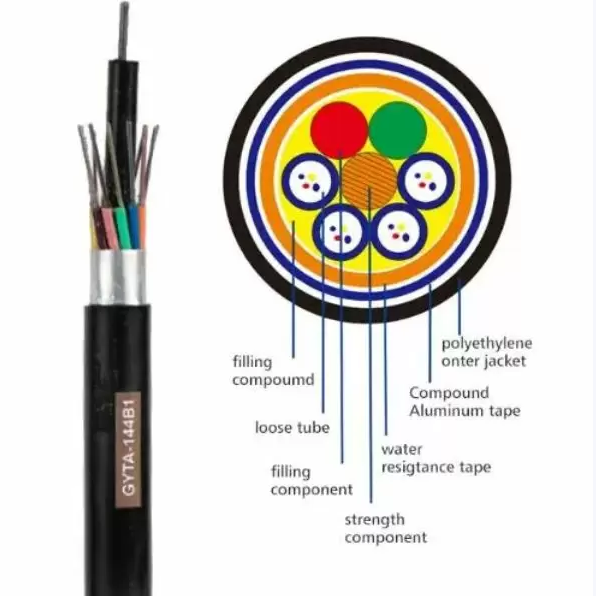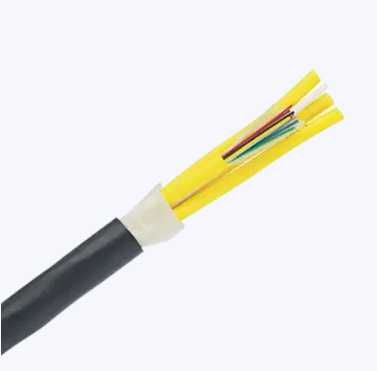

 Knowledge Base +
Knowledge Base +  2024.01.18
2024.01.18Fiber optic technology has revolutionized the telecommunications industry by offering high-speed data transmission over long distances. At the heart of this technology are fiber optic cables, which use light to transmit data. This results in less signal loss, reduced interference, and faster data transmission compared to traditional copper cables. Among the different types of fiber optic cables, single-mode fiber (SMF) cables, such as OS1 and OS2, are particularly noteworthy due to their potential for long-distance data transmission.
Understanding Fiber Optic Technology
Fiber optic technology uses pulses of light to transmit information from one point to another. This light travels through a fiber optic cable, which is made up of a core, cladding, and protective jacket. The core carries the light signals, while the cladding keeps the light within the core using a principle called total internal reflection. The protective jacket shields the inner components from damage.
Differences Between OS1 and OS2 Cables
OS1 and OS2 cables are both types of single-mode fiber cables, but they have several key differences. OS1 cables are predominantly used for indoor applications and have a maximum distance of 10km. They have a higher attenuation (loss of signal), which is typically around 1dB/km. On the other hand, OS2 cables are designed for outdoor applications and can transmit data over distances up to 200km with an attenuation of 0.4dB/km.
Benefits of Using Single-Mode Fiber Cables
Single-mode fiber cables, including OS1 and OS2, offer several benefits. They can transmit data over longer distances than multi-mode fibers due to lower attenuation rates. Additionally, they have a higher bandwidth capacity, which means they can carry more data at once. This makes them ideal for applications that require high data transmission rates over long distances, such as telecommunications and internet service providers.

Single Mode Fiber Diagram
Comparing OS1 and OS2 Fiber Cables
| Feature | OS1 Cable | OS2 Cable |
|---|---|---|
| Maximum Distance | 10km | 200km |
| Typical Attenuation | 1dB/km | 0.4dB/km |
| Application | Indoor | Outdoor |
How to Choose Between OS1 and OS2 Cables?
When choosing between OS1 and OS2 cables, consider your specific needs. If you need a cable for indoor applications and shorter distances, OS1 could be a suitable choice. However, if you need a cable for outdoor applications and longer distances, OS2 would be more appropriate. Also, consider the cost – OS2 cables are typically more expensive than OS1 cables due to their superior performance.
Transmission Distance: OS1 vs OS2
In the realm of fiber optic technology, single-mode fiber cables, specifically OS1 and OS2, are widely recognized for their ability to transmit data over long distances. The maximum transmission distance is a critical factor in defining their utility and effectiveness in different applications. This article seeks to provide a technical and professional insight into the maximum transmission distances of OS1 and OS2 cables, factors affecting these distances, their optimal applications, and considerations for selecting cables based on transmission distance.
Maximum Transmission Distance for OS1 Cables
OS1 cables, primarily designed for indoor use, can effectively transmit data up to a distance of about 10 kilometers. This makes them suitable for applications within buildings or campuses where the required transmission distance is relatively short.
Maximum Transmission Distance for OS2 Cables
Contrastingly, OS2 cables, engineered for outdoor applications, exhibit superior performance in terms of transmission distances. They can efficiently deliver data over an impressive distance of up to 200 kilometers. This makes them the preferred choice for long-haul networks and metropolitan area networks (MANs).
Factors Affecting Transmission Distances
Several factors can affect the transmission distances of fiber optic cables:
Attenuation: The loss of signal strength, or attenuation, increases with distance, reducing the maximum transmission distance.
Dispersion: As the light pulse travels, it spreads out, causing dispersion which can limit transmission distance.
Cable Quality: High-quality cables often have lower attenuation and dispersion, enabling longer transmission distances.
Installation Practices: Proper installation and handling of cables can prevent physical damage that may degrade performance and limit transmission distance.
Optimal Applications for Different Transmission Distances
The transmission distances of OS1 and OS2 cables make them ideal for different applications:
Short-Distance Applications: OS1 cables are best suited for short-distance applications such as local area networks (LANs) in offices and data centers.
Long-Distance Applications: OS2 cables are optimal for long-distance applications such as wide area networks (WANs) and metropolitan area networks (MANs).
Considerations for Selecting Cables Based on Transmission Distance
When selecting cables based on transmission distance, consider the following:
Application Requirement: Whether the application requires short or long-distance transmission.
Cost: Longer-distance cables like OS2 are generally more expensive than shorter-distance cables like OS1.
Future Expansion: If there is a possibility of network expansion, select a cable that can accommodate longer distances.
Quality and Performance: Ensure the chosen cable offers reliable performance and low signal loss over its entire transmission distance.
Optical Fiber Cable Specifications
Optical fiber cables are the backbone of modern communication networks, enabling high-speed data transmission over long distances. Single-mode fiber (SMF) cables, specifically OS1 and OS2, are particularly noteworthy due to their potential for long-distance data transmission and minimal signal loss. This article provides an in-depth analysis of the core size and performance of OS1 and OS2 fiber cables, compares their specifications, discusses mode conditioning, offers tips on maximizing performance, and outlines the standards governing these cables.
Core Size and Performance of OS1 and OS2 Fiber Cables
The core size of a fiber optic cable is crucial to its performance. Both OS1 and OS2 cables have a core size of 9 micrometers, which allows for minimal signal dispersion and maximum transmission distance. This small core size enables single-mode transmission, where only one light path (mode) travels through the fiber, minimizing signal loss and increasing bandwidth.

Outdoor 10 Gigabit Singlemode Fiber Cable 9125-OS1OS2 SM Outdoor Fiber Cable
Comparing Fiber Cable Specifications for OS1 and OS2
| Specification | OS1 Cable | OS2 Cable |
|---|---|---|
| Core/Cladding Diameter | 9/125 µm | 9/125 µm |
| Maximum Distance | 10 km | 200 km |
| Attenuation | 1 dB/km | 0.4 dB/km |
| Application | Indoor | Outdoor |
Understanding Mode Conditioning in Single-Mode Fiber Cables
Mode conditioning is a technique used in single-mode fiber cables to improve signal quality. It involves launching a laser into a multi-mode section of the cable before it enters the single-mode section. This process reduces differential mode delay, a phenomenon that can cause signal distortion in long-distance transmissions.
Additional Learning Hub Resources
Single-mode fiber vs Multi-mode fiber how to choose?
What are the types and differences between fiber optic patch cords
What are the 4 common fiber optic connectors?
Fiber optic connector general troubleshooting methods introduced
Subscribe to the newsletter
for all the latest updates.
2-5# Building, Tongfuyu Industrial Zone, Aiqun Road, Shiyan Street, Baoan District, Shenzhen. China
